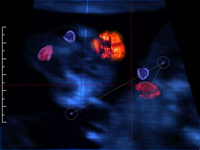
Photograph: Garth Paine
Animation: Garth Paine & Katherine Mew
e-Performance: Post-disciplinary contexts and theorisation
Yuji Sone
This special issue of Scan focuses on performance in a mediatised environment. The contributing essays for this issue are drawn from papers presented at e-Performance and Plug-ins: A Mediatised Performance Conference at the University of New South Wales, in late 2005. In this conference, scholars and artists whose backgrounds included theatre, dance, net art, sound art, installation, as well as theatre studies, media studies, cultural theory, and art history, considered electronically mediated performance from their own artistic and disciplinary perspectives in order to enrich current debate. As in the e-Performance conference, this special issue aims to consider mediatised performance under its diverse conditions of actualisation, but also to examine an appropriate language, a critical grammar, for discussing and analysing mediatised performance. Working within and across disciplinary vocabularies, contributors apply both experiential and theoretical tools to this task.
Human interaction with technology is an important area of study in an age of ubiquitous digital technology, for media studies as well as for performance studies. However, their perspectives on performance diverge. For media studies, aesthetic questions related to 'the body', the observer's participatory virtual experiences, and virtual embodiment in new media arts – often constitute the primary focus. Performance is of interest insofar as it participates in or illustrates these concerns. However, media theorists have made reference to terms and concepts borrowed from performance or theatre, as Brenda Laurel's seminal study Computers as Theatre (1991) has done to analyse human-computer interaction.
From a theatre/performance studies perspective, on the other hand, we can discern several approaches since Philip Auslander has challenged the notion of live performance in his influential study Liveness (1999). One is to situate mediatised performance within the context of the 20th-century avant-garde, particularly performance art and experimental theatre and dance. Other performing arts scholars and practitioners are concerned to develop expanded notions of theatre or dance through the innovative use of various digital technologies in theatre space, such as the Internet, digital video, and interactive or motion capture technologies.
While foregrounding performance, contributors to this issue are interested in finding a language to discuss mediatised performance. Contributors engage with mediatised performance using terms from their own disciplines, and borrow language from other disciplines – even though doing so may alter the original, contextualised meanings of these terms – in order to meet what is a pressing theoretical need. While this special issue does not focus on such meta-theoretical gaps, it presents a forum for attempts to create appropriate critical terms. Like the e-Performance conference, this special issue suggests that, despite the inherent difficulties of interdisciplinary theorisation of mediatised performance, ongoing dialogue between disciplines should be considered necessary and productive, though not conclusive.
Hazel Smith's essay, soundAFFECTs: transcoding, writing, new media, affect, discusses the process of transcoding of a page-based text, "AFFECTions: friendship, communities, bodies", into the multimedia work soundAFFECTs. Smith examines the way in which the transcoding of the piece changes its affective impact.
Maria Miranda and Norie Neumark's practice-led research essay Performing the Network discusses their networked performance, Séance: a networked glossalalia. Instead of focusing on technology and technological innovation as in many ‘new media’ discussions of media performance, Miranda and Neumark argue that performativity offers a way to approach a media artwork such as Séance.
In Sonic Immersion: Interactive engagement in real-time immersive environments, Garth Paine discusses the interactive sound environment of his installation works. While working from the perspective of the musician/sound artist, Paine attempts to theorise the audience/participants' visceral engagement with sonic architectures outside traditional music theories.
Rosemary Klich's essay, Performing Posthuman Perspective: Can You See Me Now?, examines the nature of the embodied intersection between live and online participation in Blast Theory's mixed-reality performance, Can You See Me Now?. Klich aims to extend the ongoing discussion of oppositions within theatre studies such as the live and the virtual, and presence and absence.
Meredith Morse traces the history of a significant art-and-technology collaboration of the American 1960s, 9 Evenings: Theatre & Engineering, which featured electronically mediated works by the former Judson Dance Theater dancers Yvonne Rainer, Steve Paxton, Lucinda Childs, Deborah Hay, and Alex Hay. Morse examines the new conceptions of dancers' bodies and performance spaces that these early cross-disciplinary explorations produced.